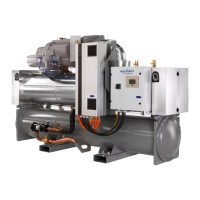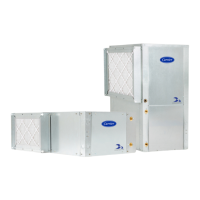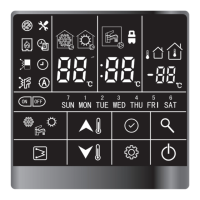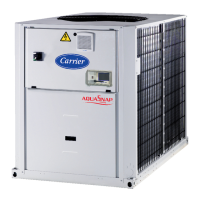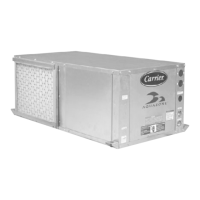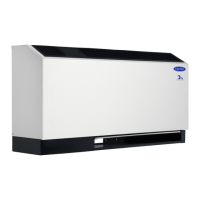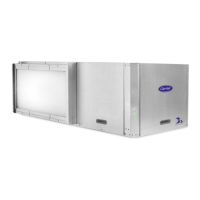30
11.9 - High pressure safety loop periodic test
In order to verify the full integrity of the safety loop, the following
checks have to be performed periodically:
Contactors check
Complete loop operation check
11.9.1 - Power contactor check procedure
This procedure shall be applied for each compressor of the unit.
1- Switch off the power of the electrical equipment.
Apply all safety procedures for access to equipment with
hazardous voltage.
2- Measure the resistance between upstream and downstream
terminals of the main power contactors KM- and KM-D for each
phase.
Note: calibrated Ohmmeter shall be used for this task.
3- Conrm resistance is more than 1.0 MOhm.
A resistance lower than 1.0 MOhm, indicates that contactor KM_
or KM_D is defective: further investigations and replacement of
the failed part is required.
Illustration for step 2: resistance measurement
Downstream terminals of
KM- and KM-D
Upstream terminals of KM- and
KM-D contactors
11.9.2 - Complete safety loop test
The purpose of this periodic test is to verify the proper functioning
and setting of the high-pressure safety loop of a refrigerant circuit.
In order to reach the triggering pressure of the loop, the pressure
and temperature thresholds activating the discharge of the
compressor by the regulation system are raised.
This procedure must be repeated for each circuit of the unit.
1. Set up a calibrated pressure gauge on the high pressure part
of the circuit (compressor discharge)
2. Reset all activated alarms
3. Activate the HP test mode for the corresponding circuit via the
control interface.
Enable Quick Test Mode (Quick Test Menu> [ QCK_TEST ]
parameter active)
Activate the high pressure test for the desired circuit (Menu Quick
Test> parameter [HP_TEST] to 0 for circuit A or 1 for the B circuit.
The corresponding circuit starts to perform the HP test.
4. Getting Started Machine
5. For water-cooled units, stop the circulation of the secondary
circuit to the condenser in order to stop the condensation and
cause the increase in pressure (this operation is managed by
the control on air-cooled machines)
6. Record the trigger value
7. Check that both HPS were triggered
If both HPS have tripped, go to step 10
If only one of the HPS has tripped, go to step 8
8. Replace the triggered HPS with another system whose trigger
value is adequate .
Alternatively, an emergency stop button can be installed.
9. Repeat steps 2 to 6
10. Check if the trigger values are correct
The release values should be between -1 .5 /+0.5 bars of nominal
values indicated on the unit.
11. Reset all alarms
12. Reset all HPS
Note:
Access to the maintenance functions can be protected by a
password. Contact your dealer or the manufacturer’s service
department for more information.
For step 8, the electrical disconnection of the triggered HPS
and its substitution must be performed in an environment
with live parts. All the procedures and authorization provided
for this type of intervention must be respected.
The type of connector must be WAGO 231-302 or equivalent.
11 - STANDARD MAINTENANCE
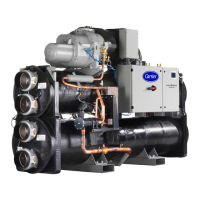
